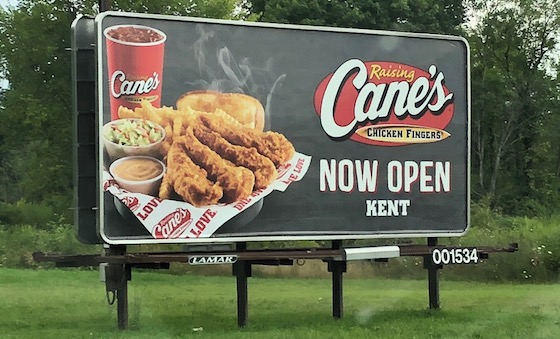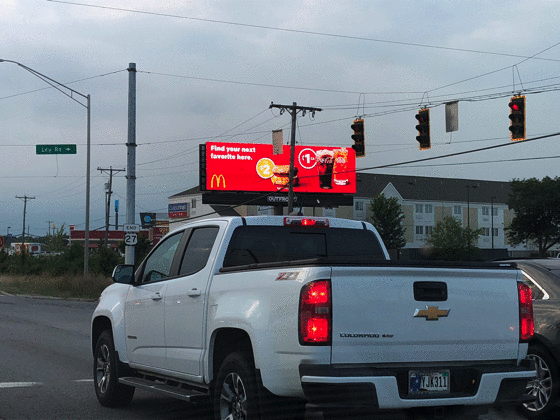Memo From Frank
I was just at an event in Las Vegas and am always reminded of the diversity of the out-of-home advertising industry every time I’m there. There are not only billboards, of course, but transit ads, mobile ads, LED – everything you can think of. Due to the competitive nature of all of the casinos, shows and restaurants virtually every square inch on the Las Vegas strip is an advertising venue. What’s interesting is that everything you see there has almost an identical business model. You rent the visual space from the landlord, and then create the advertising model and rent the advertising space. Once you know how to do one out-of-home sector, you can easily transition to any of the others. Understanding billboards is kind of like riding a bicycle, and the opportunities are endless.
I Would Rather Have This Than Money In The Bank

From all those TV commercials, it would appear that most Americans are fretting over where to place their meager savings to get the highest yield. 1-year CDs are paying around 2% right now, and 3-year are at around 3%. Or maybe you’d rather put your money in the stock market, which will garner you a whopping 7% on average. But a good billboard investment will do many times those amounts. A billboard like the one shown above can be superior to money in the bank. How?
Higher yields
Billboards such as this one have financial yields that are normally around 20% to 50%. In other words, if you built this sign for $4,000, it would not be uncommon to have a net income of $3,000 from that. $40,000 of billboards might yield $30,000 per year, but only $1,200 per year in CDs are similar financial vehicles. That means that billboards produce roughly 10 to 40 times what money does in the bank. That alone should be motivation enough to choose billboards.
Rising rents = rising rates of return
Unlike a CD – which has a fixed interest rate – billboards rents are continually escalating in keeping with inflation and market growth. So not only do billboards have the higher rate of return day one, it continually increases over time. Kind of the best of all worlds financially. I’ve owned billboards that saw their rents double and even triple in less than a decade.
Security
If you want to get more than 2% to 3% with a CD, your next option is risky junk bonds. Personally, I’d find the security of owning a billboard superior to owning a piece of paper that gives me debt on a company that I know nothing about and have no control over. On top of that a billboard is a tangible asset that you can see and touch while most financial documents are nothing but nebulous writing on a computer screen.
The value when you sell it at the end
Of course, all these financial yield examples are only based on cash flow. They do not include the actual value of the asset if you sent to sell it. Billboards are typically sold based on income using a concept called the “cap rate”. If you sold a sign you built for $4,000 for $15,000 or more, then those yields spike enormously higher.
The ability to obtain reasonable leverage
Here’s one of the important point. You can often obtain lending on a billboard, which allows you to stretch your dollar and increase your cash-on-cash return, while a traditional CD offers no such debt options. While we don’t suggest that you engage in super-high leverage, keeping your cash deployed at a 70% to 80% loan-to-value relationship is fairly conservative.
Conclusion
When most people think about savings, they think about cash in the bank. Billboards are another option that has far higher returns and even greater stability in some cases.
The Ultimate Billboard Boot Camp
![]() How to Find a Billboard Location
How to Find a Billboard Location
![]() How to Buy a Billboard
How to Buy a Billboard
![]() How to Build a Billboard
How to Build a Billboard
![]() How to Operate a Billboard
How to Operate a Billboard
![]() How to Rent Ad Space on a Billboard
How to Rent Ad Space on a Billboard
![]() How to Sell a Billboard
How to Sell a Billboard
Get Your Copy Now!
Lessons Learned From 30 Years Of Selling Ad Space

I have rented more billboards than almost anyone else in America – at least anyone else I know. Around 3,000+ individual ads sold. So what have I learned in the process? Quite a bit actually.
It’s all about volume
The first rule of selling billboard ad space is that it’s all about volume. The more sales calls you make, the more you will sell. Think about it this way. The odds of any one advertiser renting your sign is low. So you have to hit a lot of people to have the odds in your favor. On a really tough sign, that might mean making 50 to 100 phone calls to find the right advertiser. Of course, it’s a whole lot easier if you can let the sign sell itself by putting “sign for rent” on the structure itself. That reaches about 50,000 people per day on average on a U.S. highway.
And matching the sign to the right advertiser for the long haul
If you have two different advertisers interested in the same sign, what do you do? Take the higher offer? No, you’re better off selecting the advertiser that the sign is most likely to work for. One tip is that the most successful billboards are those that say “Exit Now”. Even the Harvard textbook on advertising says this. If you have a Wendy’s at the next exit and a Carl’s Jr. five miles away, go with Wendy’s. Also select advertisers that are stable financially: go with McDonald’s over Tina’s Burgers & Things.
Renewal is what makes everything work best
When billboards work for the advertiser, they will renew over and over. I’ve had signs that have had the same advertiser since the day they were built, over a decade ago. A good salesman may see renewal rates as high as 80% per year. That’s great news because every time an advertiser renews you don’t have to find a replacement.
Make sure the ad is a winner or it will be hard to get paid
It is your responsibility to make sure that the advertiser has great artwork up on the sign. If you don’t – and the ad is a loser – the advertiser will quickly complain and you will have a hard time getting your check each month. Just because the advertiser gives you some artwork does not mean it’s good. The words needs to be large, the colors highly visible and the graphic grabbing. Weak ads – even when they come from the advertiser – kill your business and eliminate any chance for renewal. Be honest with the advertiser if they are on the wrong track. They will appreciate it in the end.
Focus on how many units it takes to make a profit for the advertiser
A home builder only has to sell one home to pay for the billboard for the entire year. The dollar store has to sell like 2,000 items per month to get same result. Remember that people advertise with the expectation of making money, not spending it. Steer the sign towards those with big ticket items or high margins. Advertisers with low margins (like grocery stores at 1%) and low volume sales (like a mom & pop store in a strip mall) are perpetual problems on this front.
Be easy to buy from
There’s no substitute for great customer service. People like enthusiasm and a happy voice. Treat your advertisers like VIPs and they will reward you with their business. Give them little framed photos of the sign and send them Christmas cards. Remember the Golden Rule if you want to make the gold.
Conclusion
Renting billboards is part art form and part science. These tips will help get you off in the right direction.
The Year Is Running Out Of Time – What Have You Done Today?

We are now entering September, which means there are only four months left in the year and 2018 will be over. Have you made progress towards your New Year’s Resolutions yet? If not, it’s time to take action. If you have considered building or buying billboards, then at least do the work of learning about the opportunity and seeing if it works for you. If you started today, you could probably be well into the business by year end. But you’ve got to take that first step. Remember the old saying “behold the turtle: it only makes progress when it sticks its neck out”. There’s another saying: “carpe diem” which means “seize the day”. Don’t procrastinate. Take charge of the rest of 2018.
The Strengths And Weaknesses Of LED Signs

Everyone has seen the LED billboard – the type that changes ad messages every few seconds. But are these good to own? There are, in fact, significant issues both good and bad in this discussion. Here are some observations to consider.
The ability to put more than one advertiser on an in-demand location
LED came about from billboard owners trying to find ways to maximize their prime locations. Static signs only have one advertiser – so what do you do when you have 6 or 7 that want that same location? The answer is to share the space between them. That’s where LED came from.
Real-time opportunity to change ad copy
LED signs allow you to change the advertising copy as often as you want. You can have a restaurant advertise their breakfast in the morning, lunch in the afternoon, and dinner in the evening. You can have car dealers replace cars that sold out and put new ones up on the sign. Unlike conventional billboards, copy changes are literally at the push of a button.
Attention getting delivery
People tend to look more at signs that change copy right before your eyes. It’s human nature. This inherent attention is what makes LED really stand out and is something that no static sign can match. The ability to do this has been around since the 1980s using a crude technology called “tri-vision” (where triangular panels changed periodically) but nothing as strong as today.
Bright ad copy at night
People particularly notice LED signs at night because they are extremely bright. Standard signs have lights that shine from the outside in, but LED are like mini-flashlights shining out. There’s no comparison in legibility at night. None.
High revenues
Clearly, signs that are “shared” between advertisers have greater revenue. Most LED signs have 6 or 7 advertisers and that means many multiples of static sign rents. That’s why many billboard owners have an interest in the technology to begin with – they are trying to find ways to significantly increase income.
The difficulty of finding customers
When you rent static signs, it’s easy to find customers because everyone is familiar with the product. But LED is different. It takes a special advertiser to want to “share” the sign with others, as well as the unique delivery of not having a traditional vinyl-wrapped ad message.
High cost and future cost
LED signs are not cheap. They cost around $100,000 for a standard 14’ x 48’ ad face. And that’s not a permanent investment as you have to change them out every decade or so as the lights wear out. This is one of the big roadblocks for many to use the technology – it’s a huge upfront investment.
Hard to read during the day
While LED works great during the night, it’s not that impressive during they day, when it has to compete with sunlight. Science would suggest that static signs are actually more legible during the day, as LED seems to come off fuzzy. Look for yourself.
Conclusion
LED signs can be great in many applications. But there are also negatives to consider. Every sign and its location is unique.
